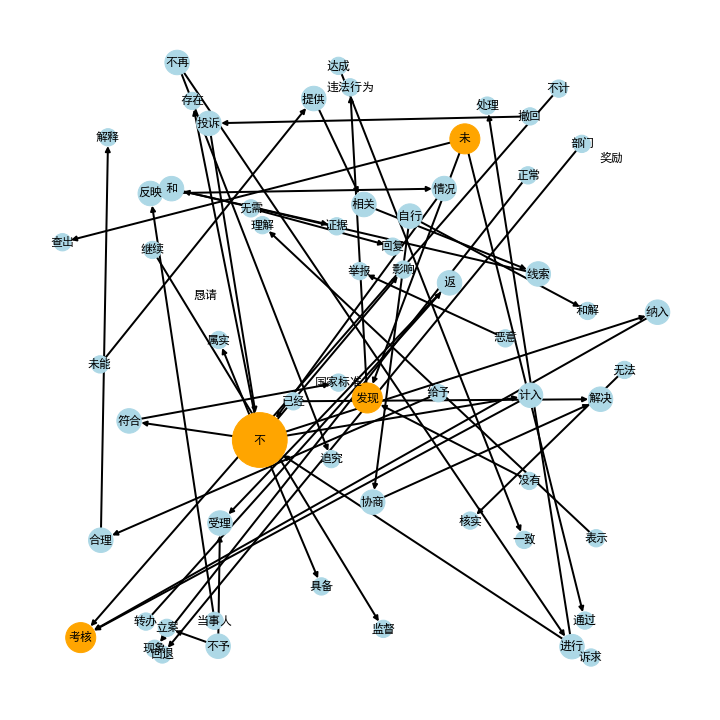 PDF(2075 KB)
PDF(2075 KB)


Research on hotline text data crime clue screening method based on keyword mining
Zhen Muhua, Chen Peng, Wang Kun, Fan Ziyang, Wang Zhe
Knowledge Management Forum ›› 2022, Vol. 7 ›› Issue (5) : 539-548.
 PDF(2075 KB)
PDF(2075 KB)
 PDF(2075 KB)
PDF(2075 KB)
Research on hotline text data crime clue screening method based on keyword mining
[Purpose/Significance] Aiming at the problem of insufficient information analysis ability in the current public security business about identification and screening of crime clues in hotline texts, a method of hotline text data crime clue screening based on keyword mining is proposed to help business departments improve relevant intelligence and judgment [Method/Process] Considering that algorithms such as automatic text classification are subject to the problem of sample size, this paper firstly identified the key information of the known attribute data and established a seed lexicon, and then used Word2Vec to expand the seed vocabulary from the perspectives of similar words and synonym words to form a professional thesaurus, and finally used a semantics-based integral screening model to screen criminal clues in the hotline text data. [Result/Conclusion] This paper conducted a crime clue screening experiment on 1 050 priori hotline text data in Jinan City. After actual comparison and index analysis, the recall rate reached 86%. The specific identification of crime information in the text data of the city hotline achieved the expected effect and realized the effective screening of crime clues.

hotline text / professional thesaurus / text similarity / crime clue screening
| [1] |
王勇.大数据在我国食药智慧监管中的应用[J].中国食品药品监管,2018(5):44-47.
|
| [2] |
袁猛,刘文杰,胡建华,等.“昆仑2020”:全方位构筑食药环安全防线[J].人民公安,2020(16):30-33.
|
| [3] |
徐建民,王金花,马伟瑜.利用本体关联度改进的TF-IDF特征词提取方法[J].情报科学,2011,29(2):279-283.
|
| [4] |
彭云,万常选,江腾蛟,等.基于语义约束LDA的商品特征和情感词提取[J].软件学报,2017,28(3):676-693.
|
| [5] |
刘耕,方勇,刘嘉勇.基于关联词和扩展规则的敏感词库设计[J].四川大学学报(自然科学版),2009,46(3):667-671.
|
| [6] |
刘亚桥,陆向艳,邓凯凯,等.摄影领域评论情感词典构建方法[J].计算机工程与设计,2019,40(10):3037-3042.
|
| [7] |
谭敏博.基于知识图谱的谷类作物病害识别及个性化推送研究[D].长沙:湖南农业大学,2018.
|
| [8] |
夏松,林荣蓉,刘勘.网络谣言敏感词库的构建研究——以新浪微博谣言为例[J].知识管理论坛,2019,4(5):267-275.
|
| [9] |
唐晓波,高和璇.基于关键词词向量特征扩展的健康问句分类研究[J].数据分析与知识发现,2020,4(7):66-75.
|
| [10] |
姜天宇,王苏,徐伟.基于朴素贝叶斯的中文文本分类[J].电脑知识与技术,2019,15(23):253-254,263.
|
| [11] |
吴绍忠.重点人员积分预警模型建设基础问题研究[J].中国人民公安大学学报(自然科学版),2012,18(2):76-79.
|
| [12] |
涂铭,刘祥,刘树春.Python自然语言处理实战核心技术与算法[M].北京:机械工业出版社,2021:120,129.
|
| [13] |
严红.词向量发展综述[J].现代计算机(专业版),2019(8):50-52.
|
| [14] |
CHEN K J, MA W Y. Unknown word extraction for Chinese documents[C]// Proceedings of international conference on DBLP. Taipei: Morgan Kaufmann Publishers, 2002:169-175.
|
| [15] |
PEDERSEN T, KULKARNI A. Identifying similar words and contexts in natural language with sense clusters[C]//Proceedings of the 20th national conference on artificial intelligence. Pittsburgh: AAAI Press, 2010:1694-1695.
|
| [16] |
NEVIAROUSKAYA A, PRENDINGER H, ISHIZUKAM. SentiFul: a lexicon for sentiment analysis[J].IEEE transactions on affective computing,2011,2(1):22-36.
|
甄沐华:设计研究方法,完成实验,起草论文,修改论文与定稿
陈鹏:提出研究思路,修改论文
王坤:提供数据,提出研究问题
范子杨:采集数据,进行实验
王者:集数据,进行实验
/
| 〈 |
|
〉 |